Healthcare can't stop evolving: innovation as the catalyst for unleashing the managerial potential of value-based healthcare by stimulating intangible assets and enhancing organizational resilience
- PMID: 39364090
- PMCID: PMC11447451
- DOI: 10.3389/fpsyg.2024.1438029
Healthcare can't stop evolving: innovation as the catalyst for unleashing the managerial potential of value-based healthcare by stimulating intangible assets and enhancing organizational resilience
Abstract
Background: With increasing healthcare service utilization and the introduction of costly therapies, healthcare organizations are pressured to deliver cost-effective services within constrained budgets. Rising costs and the need for efficient healthcare delivery are major concerns for governments, insurers, and health plans.
Objectives: It aims to understand the impact of these intangible assets on creating value and organizational resilience in healthcare, informing better practices and strategies for VBHC implementation.
Methods: An applied research approach using the Work Breakdown Structure (WBS) methodology was adopted. The research was divided into seven interconnected Work Packages (WPs), each designed to investigate different aspects of the integration between VBHC and intangible assets, with a focus on enhancing organizational resilience through innovative health processes. Key methodologies included literature reviews and qualitative analyses, employing Open Innovation and Design Thinking.
Results: The study revealed a dynamic interplay between VBHC, organizational resilience, and intangible assets. It showed that managerial effectiveness is influenced by direct patient outcomes and elements like intellectual capital and organizational reputation. Data integration from various Work Packages provided new insights into how intangible assets underpin VBHC strategies, proposing novel management approaches. Findings highlight the essential role of intangible assets in enhancing service delivery and fostering sustainable healthcare practices.
Discussion: The study highlights a significant oversight in the integration of intangible assets within healthcare organizations, despite their crucial role in optimizing VBHC. It supports literature emphasizing the importance of intellectual capital and organizational culture in enhancing healthcare management efficiency and resilience. A paradigm shift in VBHC to include these assets is needed for building a more adaptable and sustainable healthcare system. This integration can lead to better clinical outcomes, patient satisfaction, and overall healthcare efficiency, aligning more closely with VBHC goals.
Conclusion: Recognizing and effectively managing intangible assets are paramount for the successful implementation of VBHC and enhanced organizational resilience. Strategic integration of these assets into healthcare management practices can significantly improve patient outcomes and create a more sustainable, patient-centered, and resilient healthcare system. Future studies should develop methodologies for robust measurement and integration of these assets to fully realize the potential of VBHC.
Keywords: applied research; healthcare innovation and quality; healthcare management; organizational resilience: intangible assets in healthcare; patient outcomes measurement; value-based health care; work break structure.
Copyright © 2024 Gaspary, Gerhardt, de Freitas Michelin, Lopes, Rosa and Siluk.
Conflict of interest statement
The authors declare that the research was conducted in the absence of any commercial or financial relationships that could be construed as a potential conflict of interest.
Figures





Similar articles
-
Implementing value-based healthcare: a scoping review of key elements, outcomes, and challenges for sustainable healthcare systems.Front Public Health. 2025 Apr 9;13:1514098. doi: 10.3389/fpubh.2025.1514098. eCollection 2025. Front Public Health. 2025. PMID: 40270723 Free PMC article.
-
Identifying intangible assets in interprofessional healthcare organizations: feasibility of an asset inventory.J Interprof Care. 2019 Sep-Oct;33(5):583-586. doi: 10.1080/13561820.2018.1544118. Epub 2018 Nov 11. J Interprof Care. 2019. PMID: 30415591
-
Reflections on Managing the Performance of Value-Based Healthcare: A Scoping Review.Int J Health Policy Manag. 2023;12:7366. doi: 10.34172/ijhpm.2023.7366. Epub 2023 May 31. Int J Health Policy Manag. 2023. PMID: 37579381 Free PMC article.
-
A decade of change towards Value-Based Health Care at a Dutch University Hospital: a complexity-informed process study.Health Res Policy Syst. 2024 Aug 5;22(1):94. doi: 10.1186/s12961-024-01181-z. Health Res Policy Syst. 2024. PMID: 39103922 Free PMC article.
-
Value-Based Healthcare: A Primer for the Dermatologist.Dermatology. 2024;240(5-6):814-822. doi: 10.1159/000539372. Epub 2024 Jun 27. Dermatology. 2024. PMID: 38934138 Free PMC article. Review.
Cited by
-
Bridging epigenetics and pharmacology through systematic reviews tailored to WBS methodology: the triangle decision-making model as a pioneering translational biological drug delivery system.Front Med (Lausanne). 2025 May 20;12:1552904. doi: 10.3389/fmed.2025.1552904. eCollection 2025. Front Med (Lausanne). 2025. PMID: 40463968 Free PMC article.
References
-
- Arnott R., Harvey C. R., Kalesnik V., Linnainmaa J. T. (2021). Reports of value’s death may be greatly exaggerated. Financ. Anal. J. 77, 44–67. doi: 10.1080/0015198X.2020.1842704 - DOI
-
- Baglioni E., Campling L., Hanlon G. (2021). Beyond rentiership: standardisation, intangibles and value capture in global production. Environ. Plan A Econ. Space 55, 1528–1547. doi: 10.1177/0308518X21997835 - DOI
-
- Baldi G., Bodmer A. (2017). Intangible investments and international business cycles. I Econ Econ Policy. 14, 211–219. doi: 10.1007/s10368-016-0339-1 - DOI
-
- Bana e Costa C. A. B., Ensslin L., Cornêa É. C., Vansnick J. C. (1999). Decision support systems in action: integrated application in a multicriteria decision aid process. Eur. J. Oper. Res. 113, 315–335. doi: 10.1016/S0377-2217(98)00219-7 - DOI
Publication types
LinkOut - more resources
Full Text Sources

